How to create a vector arcade machine Atari Asteroids
- Transfer
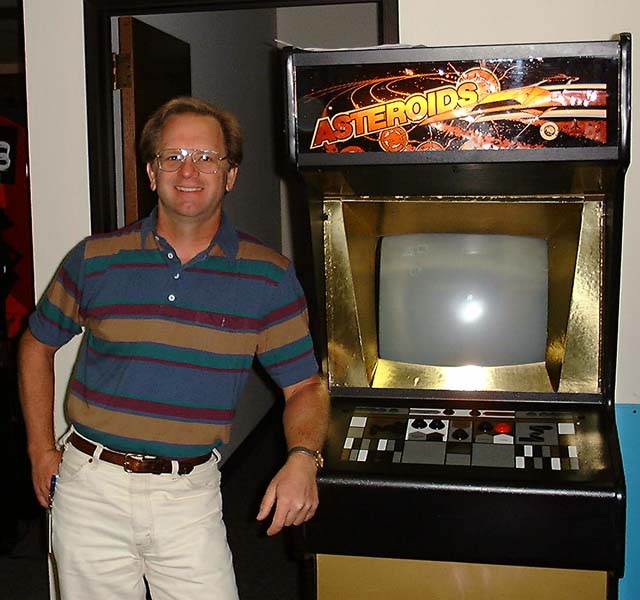
The best-selling Atari arcade game of all time called Asteroids literally changed the rules of the game. Released in December 1979, the machine became the cause of the explosive growth of Atari’s popularity with the public. This single-handed game destroyed the Space Invaders monopoly in the world of video games.
The game was created by Atari developer Ed Loggom (whose list of projects includes Super Breakout , Video Pinball , Asteroids , Centipede , Millipede , Xybots , Gauntlet , Space Lords and Steel Talons), but the history of its origin will still be interesting to explore.
I think I can call myself the father of Asteroids. Ed Logg was the mother of Asteroids, because he had been carrying the game for nine months and created the finished product. All I had to do was throw the seed.
These are the words of Lyle Raines (boss Ed at the time). Raines reflected on the previous game that was being developed inside Atari. In it, two players tried to shoot down each other (in the style of Computer Space ), and between them there was a huge rock. The game was boring, and all the players wanted to shoot the rock, but, of course, they could not. As a result, the game "put on the shelf."
In a conversation with Edom, Raines tried to describe his idea: a game in which there is a “fulfillment” of the task (as in Space Invaders and in the previous game of Loga Super Breakout ), but this time with stones. The player must shoot the stones, they become smaller and finally disappear.
Raines and Logg will recall that this discussion was very brief. There were no particular details at this stage, just the emergence of a very general idea. However, the name they came up with quickly - Asteroids .

The top of the Asteroids machine
Inspired by the conversation, Ed set to work. He promoted the idea of developing games on vector equipment. Going against the will of Raines, who wanted a raster game, Ed imagined greater accuracy and resolution on the same (at that time new and innovative) equipment that was used to develop Lunar Lander . He quickly got on the trail of Atari electronics engineer Howard Delman, who carefully listened to Ed's idea. Remembering about another game, missing in obscurity, he took out a vector card and connected it. The game was called Cosmos , and later Planet Grab. In it, two players flew across the screen, trying to steal planets from each other. But it did not seem interesting to anyone, so its development was stopped. As soon as Ed saw this prototype at work, he realized that this would be an ideal starting point for the game Asteroids .
For a couple of days, Delman developed a basic hardware development kit with which Logg could work. In fact, it was a modified Lunar Lander board :

The original vector PCB Lunar Lander, which was used to create the Asteroids. Pay attention to the small daughter board on the left, which contains additional memory, which is necessary to run the new Asteroids code. The blue jumper wires were added to modify the equipment, and the satellite board, connected below, was assembled by hand to play the sounds of the game. After the creation of the game was completed, a single board was developed that includes all the equipment. Photo of Howard Delman.
While waiting for a prototype of the equipment to be created, Logg first set out the basic concepts of the game on paper. Below is the first Asteroids planning document written by Logg himself.
Surprisingly, the finished game is almost the same as the description in this document:
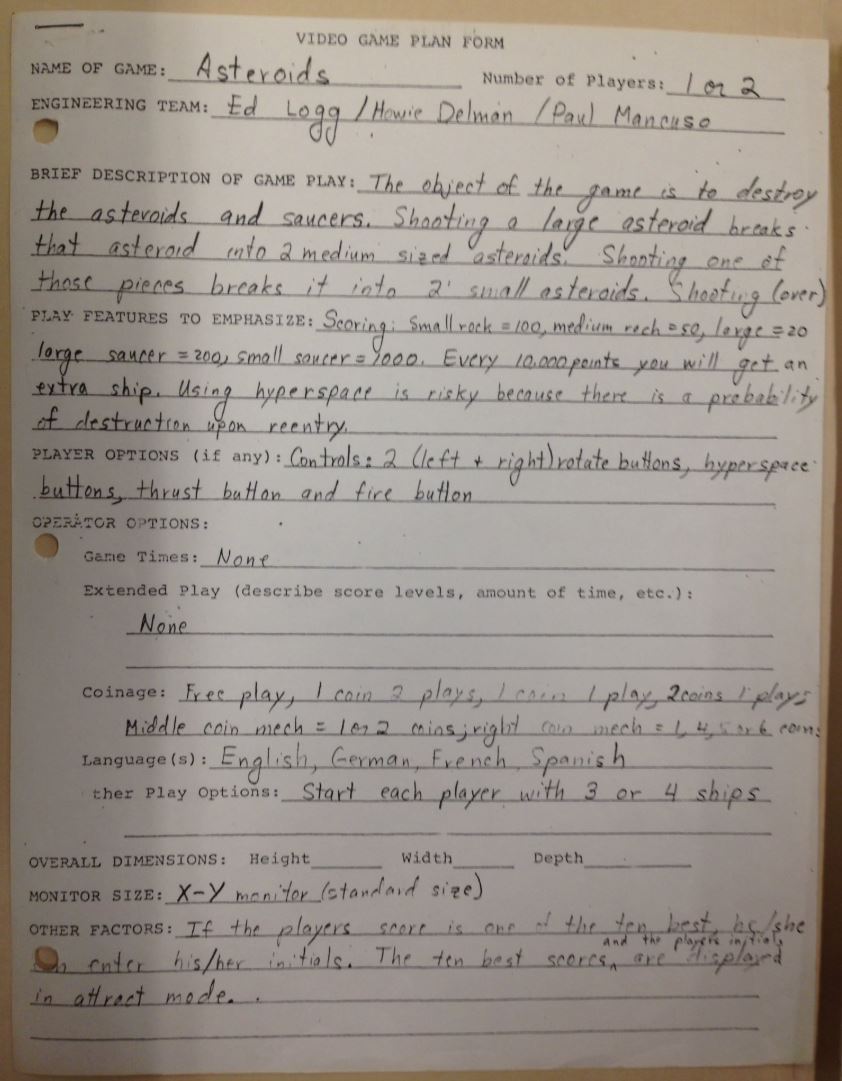
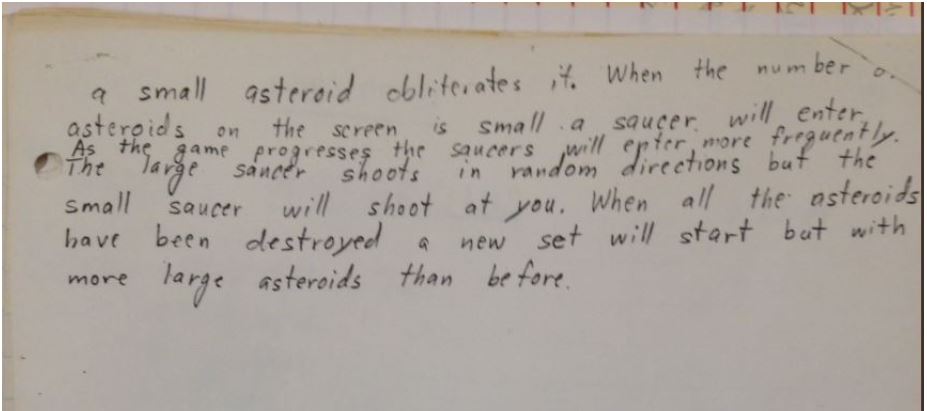
Source: Museum of Play, Rochester (New York).
The goal of the game is to destroy asteroids and flying saucers. When fired at a large asteroid, it breaks into two medium-sized asteroids. A shot at one of these fragments breaks it into two small asteroids.
Another interesting document of the development process can be found here .
Logg recalls how intense the development process was:
I shot asteroids all night. I lost the game again and again in my head, as if playing in reality. To some extent, mentally, I played many games even before writing them down, because before starting programming, you need to think through all the interactions. I know how everything will look when the development has not yet begun.
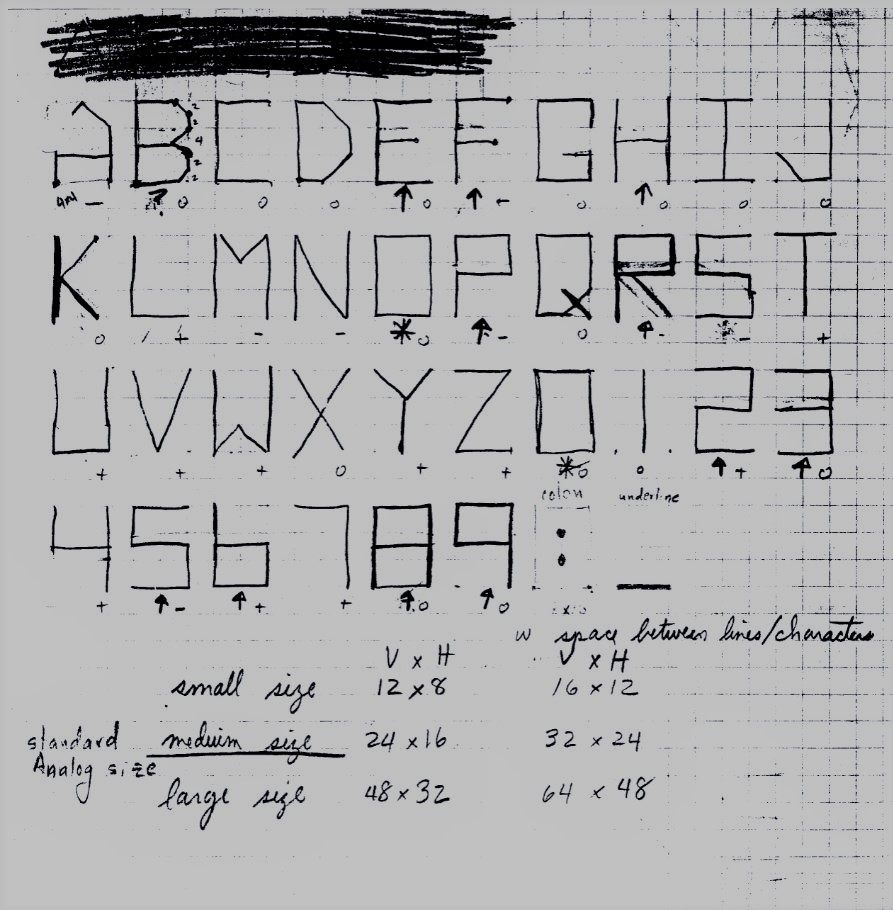
Font Asteroids. The design was invented and hand-painted by Ed Logue in this 1979 document. (From the Ed Log's archive)
Having played in the Asteroids , it is worth taking a step back and appreciating Logg's ability to create ingenious design. He experimented with the inertia of the player’s ship so that the gameplay was perfectly correct — at some point the ship didn’t have any friction at all, which simplified the game too much. Another idea was a sharp increase in the ship's thrust, but this led to too many random deaths. The player felt that he did not fully control the ship. Selection of the intermediate slip effect of the ship provided a balance between controllability and danger.
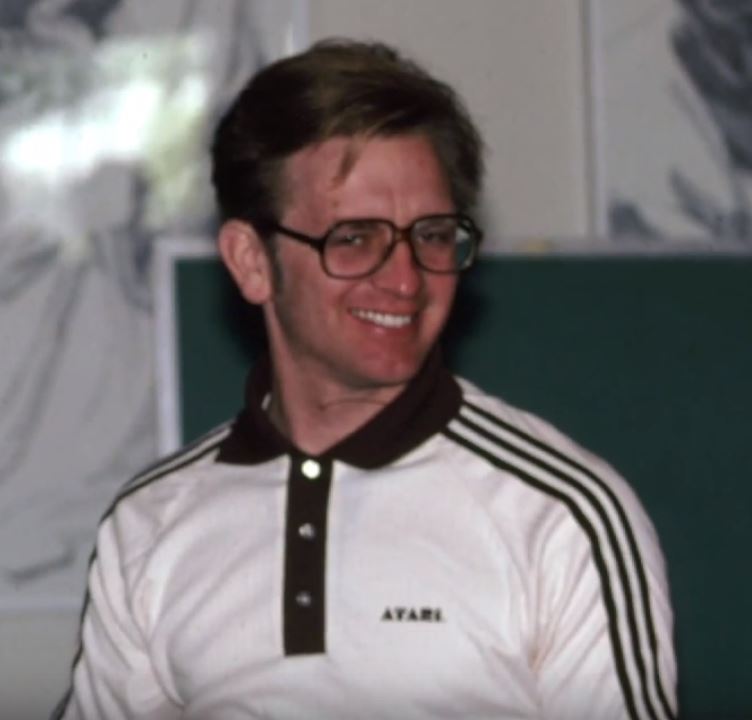
Photo by Ed Logue, circa 1982
A side effect of using vector equipment was some notable Asteroids features . In addition to simple white vectors on a black background, Logg mentions a glow following the player on the screen and resembling a jet trail from the stern of the ship. It turned out quite unintentionally, just for cooling the phosphorus of the contour of the ship on the monitor of the arcade machine took some time.

The original design of the ship from Asteroids, drawn by Ed Logue. Above crossed out the original version. (From the Ed Logos collection)
The stones themselves made the players create strategies in the game. Asteroids whole universelocated on a single screen, but the folding mechanics used allowed all objects that moved off the edge of the screen to appear on the opposite side and continue on their way. The only way to deal with asteroids is to shoot them. They could not just fly away from the screen. So Logg discovered that the first players (usually fellow developers and engineers from the Atari factory) developed various ways of dealing with the outside world. Some shot at everything they could, others treated the flying rocks more thoughtfully, either completely avoiding them, or shooting them one at a time.
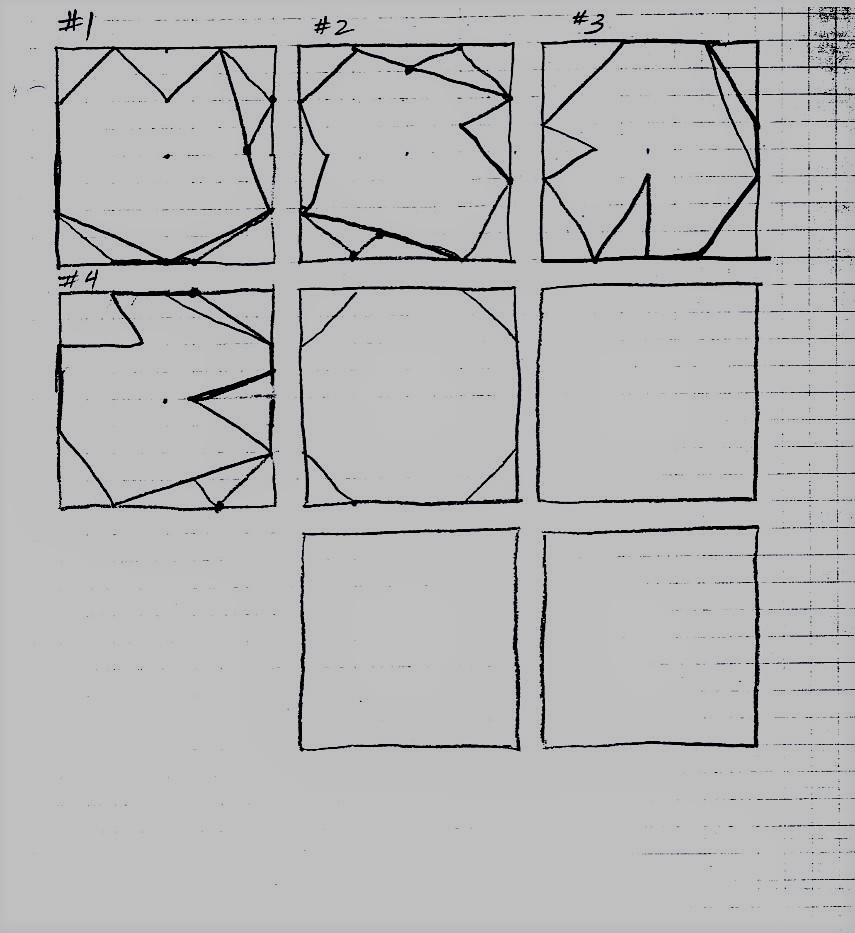
Initial sketches of Ed Log's stones for Asteroids. (From the Ed Logos collection)
Watching colleagues handle the game, Logg decided that he wanted to motivate the player to move around the screen and keep shooting.
I wanted the players not to try to avoid shooting. As soon as the players got rid of the small stones, I could create a new batch of large ones, because the more objects on the screen, the higher the probability of a collision.
Flying saucers appear on the scene:
Two flying saucers were developed and added to the game - one stupid, the second smart. The big one shot randomly, which destroyed the players' plans for convenient protection from asteroids, because the shots could easily fall into the stones flying by. The smaller UFO was harder to hit, and besides, it was always deadly accurate and aimed at the player’s ship. Here is how the developer describes it:
I always wanted to have two plates. Large, shooting randomly, like cannon fodder, so that the player is accustomed to the concept of the appearance of an enemy ship after the destruction of several asteroids. The little plate should have made the player move. Run away, they will kill you if you stand still!
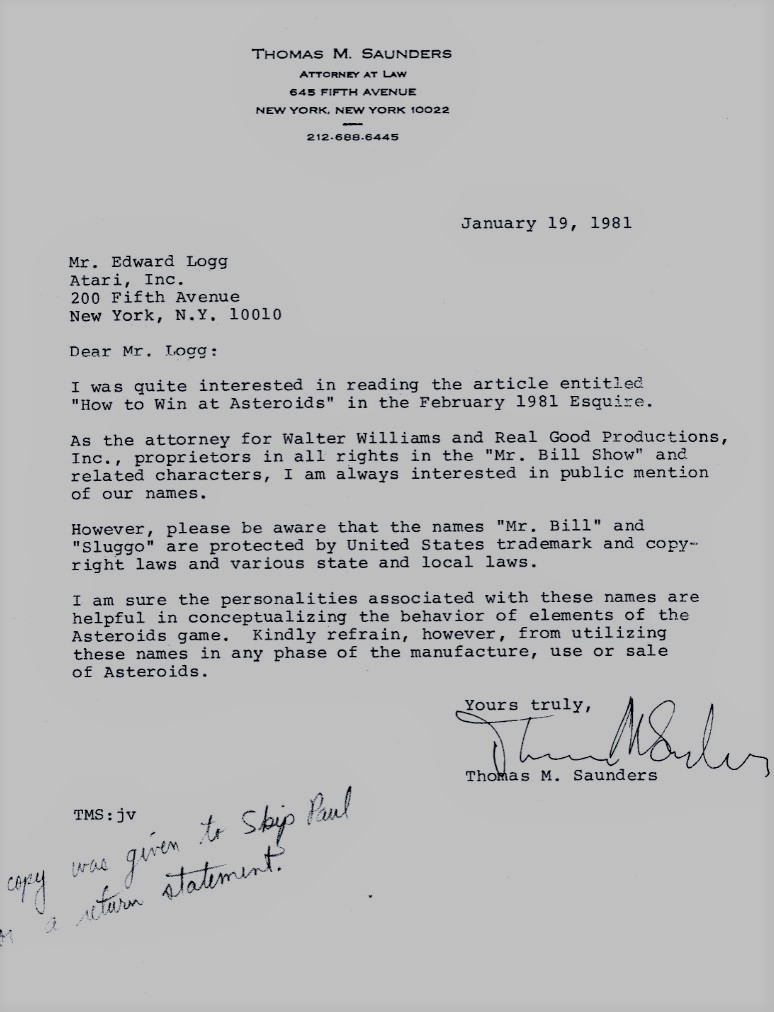
It's funny that after the names of two flying saucers, under which they were known inside the Atari Coin-Op department (“Mr Bill” and “Sluggo”), were mentioned in a magazine article, a lawyer representing the interests of the television show sent a letter to Atari. “The Mr Bill Show”
Years later, Logg said he would change two aspects in the finished game: the “Hyperspace” button and the behavior of the small plate:
The Hyperspace button was located away from the other four control buttons. After pressing it, the ship disappeared and appeared in some other place on the screen in a one-to-six probability, which, when returned, would explode the ship. Convenient function, invented as the last chance in case of imminent death. But many players have never used it, because it was difficult to reach the button!
Initially, a small plate was programmed to shoot a player immediately after its appearance. But when testing, the players said that it was not fair, so Logg changed the algorithm of the dish so that when the first shot it missed the player, giving him a chance to respond. This led to the (sadly) known “ambush” tactics that players use to this day: you can leave a single asteroid on the screen and score 1000 points by shooting plates as they appear on the screen.

Work on the design of the animation of the explosion of the ship, the rejected idea of the ship of the player and the design of the flying saucer. (From the Ed Logos collection)
Field tests were conducted on two groups of players, young and old. The feedback was very positive. Here you can read the testing report. (From the Ed Log's collection). Logg was inspired:
When we conducted the first Asteroids testing on the players, I saw one person start the game and die three times, each time within 20 seconds. He continued to thrust into the machine quarters. This made me understand that the player considers death to be his fault, and he is sure that he can play better. This is one of the main goals that a game designer is trying to achieve, and it was obvious to me that Asteroids succeeded.
Another confirmation that the game will be successful.

Original flyer for the sale of Atari Asteroids.
Production began at the end of 1979. In a 1981 interview, Atari marketing analyst Mary Takatsuno shared interesting information about how the game was perceived within the company.
Asteroids was the only game that stopped production lines at our plant. During the break, the entire assembly line was assembled to play on the machines, already ready for shipment. In the production of other games, the guys just collected them and put them in the packaging. But in the case of Asteroids, no one wanted to work.
Logg knew he created a hit. The game has had a huge impact on Atari's earnings. Having surpassed sales of everything that Atari was released before, Asteroids quickly became part of the situation not only in gaming halls, but also in other places: bars, airports, shopping centers and waiting rooms. The owners of slot machine halls demanded that they sell a new game. There were reports that some machines earned a thousand dollars in a week, so that investment in the game was returned in a matter of days.

The children crowded around the vertical Asteroids machine, circa 1980.
Such huge demand led to the sale of more than 75,000 cars, which provided Atari with huge incomes and greatly influenced the pop culture of the time. Arcade machines have become mainstream and are no longer viewed as entertainment for teenage boys. Thirty-year and forty-year-old professionals gathered around the automats for lunch breaks and played with the children and all those attracted by the vector glow of the game.
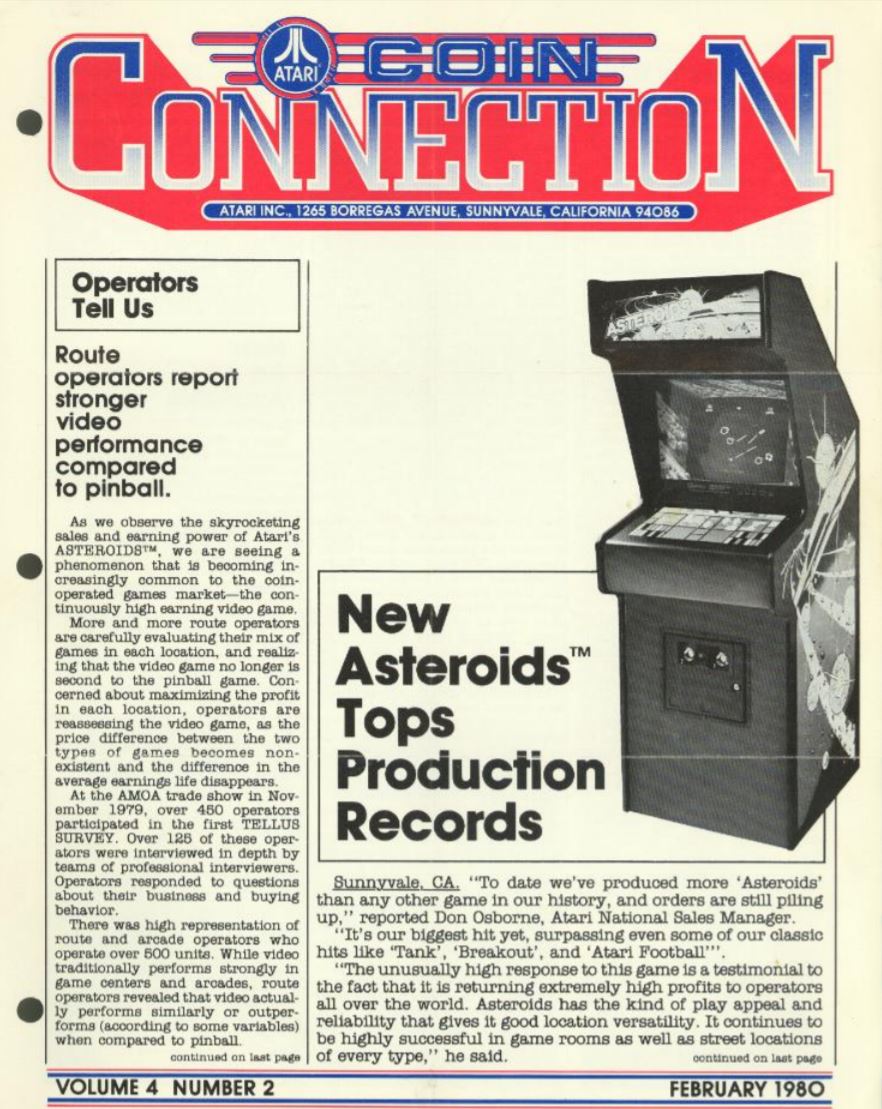
Atari's Coin Connection Release for February 1980: This is a monthly mailing list for owners and game halls and distributors, telling about the success of Asteroids
Asteroids has attracted players from all walks of life, including rock stars. Ronnie James Dio turned out to be a huge fan of the game - his personal machine was auctioned out shortly after his death for $ 5120. There is even a video where he and his group play a game .
The late Atari sales director, Don Osborne, said in 1980 that Asteroids, at the height of its popularity, was earning $ 10 million a quarter in a week — amazing statistics, if you think about it.
In total, three types of automata were produced - vertical, “cabaret” and “cocktail table”.
The success of the game led to the appearance of the inevitable sequel - Asteroids Deluxe . Having saved the mechanics of the original, Deluxe accelerated the gameplay and added new features - this turned out to be another serious Atari hit.

The continuation of Asteroids, Asteroids Deluxe, was made at the Atari plant in Tipperri, Ireland. (Photo by Mike
Geng ) The Atari Logga legacy continued with the creation of Centipede and Gauntlet , which were also popular games, but Asteroids really took off. The inexplicable ability of Logga to create an exact balance between risk and reward defined the basic Atari mantra "It is easy to learn, difficult to become a master." Thanks to his gift, he received the nickname “golden boy” on the sidelines of Atari.

"Golden Boy" Ed Logg with gold Asteroids, made in honor of the creation of 50 thousand machines. It is believed that now this machine is in the office of Midway / Warner Bros in Chicago.
The secret of success was Logg's incredible ability to perfectly customize individual elements of the gameplay. His former colleague from Atari Games, Mark Cerny, said the following in 2012:
From Ed, I learned that to create an exciting game, it’s not the complicated algorithms that are important, but the correct approach. I want to say that the success of Ed's games was determined not by virtuoso code, but by building the right elements in the right order.
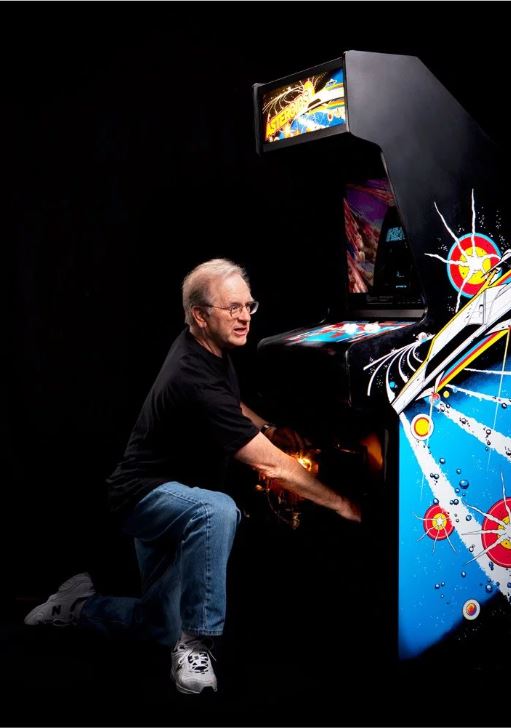
Gregg Seagal
Today, Asteroids remains the heart of the collection of any fan of arcade machines. I have a cabaret version of the game (with a kit that allows you to play Asteroids , Asteroids Deluxe and Lunar Lander ). If you want to read about the recovery process that I performed, then the article is posted here .
